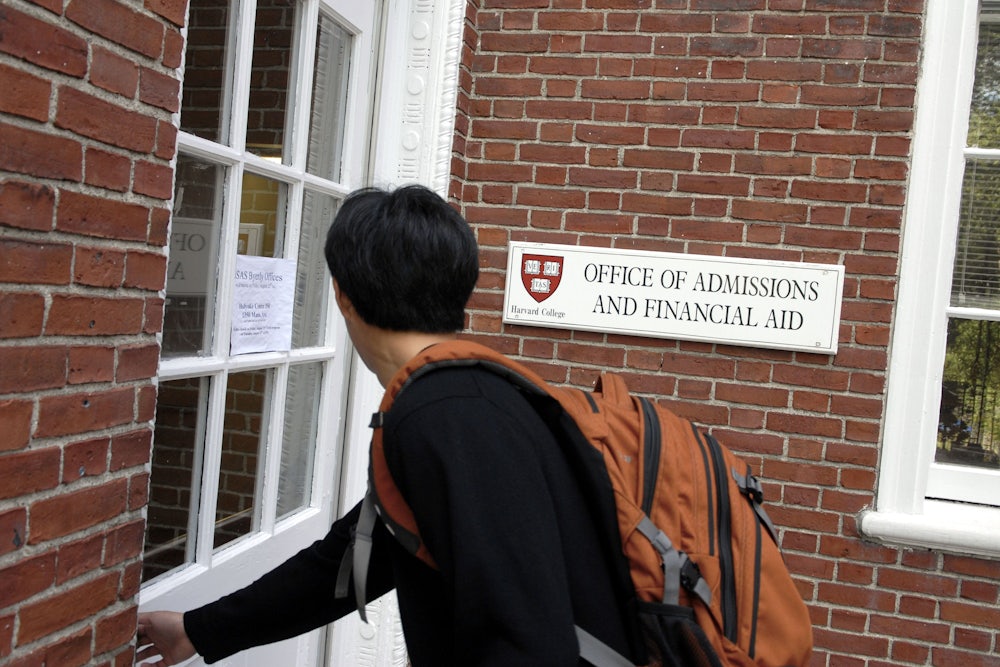In 1993, I benefited from affirmative action—as an Asian American. The official name of my graduate fellowship was a mouthful: “The Rackham Merit Fellowship for Historically Underrepresented Groups.” Back then, it struck me as slightly oxymoronic, “merit fellowship” running headlong into “historically underrepresented,” a term that suggested racial preferences and therefore affirmative action. I was accepted by the University of Michigan because I was something of a rarity in those days—an Asian American pursuing a doctorate in English.
Thirty years later, the concepts of “Asian American” and “affirmative action” can seem far less compatible, especially if one believes that Asian Americans don’t need such a policy or are even harmed by it.
Students for Fair Admissions, or SFFA, an anti–affirmative action organization founded by political activist Edward Blum, believes exactly that. In its case before the Supreme Court, SFFA v. Harvard, SFFA claims that Harvard University discriminates against Asian American applicants by rating them lower in certain personal traits—having less “leadership ability” than other students, for example. Harvard uses the ratings to balance its incoming class by race, the argument goes, which means that Asian Americans are consistently underrepresented relative to other racial groups. In 2019, a federal district court found no evidence of Harvard discriminating against Asian Americans.
An SFFA victory would threaten not only affirmative action but also the use of race in any official capacity at every college and university in the United States receiving federal funding. (SFFA is also suing the University of North Carolina on similar grounds.) What’s at stake is not only an official commitment to campus diversity and leveling the playing field, but a more fundamental interest: the power to see race as group identity in historical terms.
I went to Michigan to do just that, training to become an English professor specializing in Asian American literature among peers and mentors who were also Asian American. The premise behind my fellowship, after all, was that systemic racism overrepresented white students in most fields of study at the time. The premise behind SFFA’s position, on the other hand, is that Asian Americans should be even more overrepresented in elite institutions than they are now.
The historical case for affirmative action has been on life support since 1978, when, in California v. Bakke, the court stipulated that the policy’s rationale must be diversity, not racial remediation. Allan Bakke, a white man, began the colorblind process of stripping white racial identity of historical meaning, envisioning it as simply a skin color among skin colors. SFFA is now asking the court to finish what it started by overturning multiple precedents—including Grutter v. Bollinger (2003), fought over the University of Michigan’s admissions policy—to force Harvard to stop asking for the race of its applicants altogether.
Only by ignoring the legacy of state-sponsored racism does SFFA’s take on affirmative action make sense, but that is where the justices appear to be headed. In its brief to the court, SFFA conspicuously quotes Chief Justice John Roberts’s own words. Twice. They are taken from Parents v. Seattle (2007), a case involving the allocation of students by race in public schools. “The way to stop discrimination on the basis of race,” Roberts famously wrote in his opinion, “is to stop discriminating on the basis of race.” By ruling against integrating the school districts, Roberts made clear his preference for colorblind approaches to inequality.
Roberts regards race as an invidious distinction whose time has passed rather than as a living idea that can build group identity and solidarity. In his oral argument defending Harvard, attorney Seth Waxman compared the “tip” a student’s race might confer to what an accomplished oboe player might get in any given year. Roberts replied, “We did not fight a Civil War about oboe players. We did fight a Civil War to eliminate racial discrimination.” Roberts conflates race consciousness with racial discrimination. To see race and act, he implies, is to perpetuate racism.
Yet that is what the Framers of the Constitution seem to have done. In the oral arguments for Allen v. Milligan, a case that upheld a section of the Voting Rights Act, Justice Ketanji Brown Jackson offered a better way to understand the Fourteenth Amendment, whose equal protection clause underwrites SFFA’s claim of a Title VI violation. Its purpose was not colorblindness but social justice for Black people through race consciousness. “I don’t think that the historical record establishes that the founders believed that race neutrality or race blindness was required,” Jackson pointed out, because the Fourteenth Amendment was drafted to give “a constitutional foundation for a piece of legislation that was designed to make people who had less opportunity and less rights equal to white citizens.” The same might be said for affirmative action.
In its brief to the court, SFFA argues that racial diversity does not necessarily yield a diversity of “backgrounds, experiences, and viewpoints,” and so affirmative action does not lead to the compelling governmental interest of diverse learning. Harvard’s brief responds by saying that it is a “commonsense reality” that race shapes our views but doesn’t explain why.
Because all of us consciously or unconsciously engage with skin color as an idea charged with historical meaning—unlike say, eye color—students of color can shape a discussion without saying a word. In a racialized society, we can’t help but see each other as members of groups. In class, I routinely observe white students endeavoring to articulate their thoughts to students of color with precision and respect—and vice versa. Such a skill will serve them well after college.
Asian Americans, most of whom support affirmative action, know that race consciousness is necessary because the social meaning of our bodies has never been static. In graduate school I learned how Chinese and Japanese stereotypes morphed to reflect tensions in international affairs and the political economy, the reason why Asian Americans are now seen as the victims of affirmative action. The history of Southeast Asian Americans in this country, moreover, belies the anti-Black model minority myth undermining affirmative action. Even Michael Wang, once a full-throated opponent of affirmative action, now regrets his role in bringing the question of its constitutionality to a head, which included a meeting with Blum.
Regardless of the court’s ruling, the idea of race as a social construction will continue to survive in higher education. But the effort will be more difficult and dangerous without legal and institutional backing, especially in a political climate hostile to discussions of race at any level of education.
After the state of Michigan banned affirmative action by voter referendum in 2006, I noticed that the name of my old fellowship changed to the “Rackham Merit Fellowship,” and belonging to an underrepresented racial group was no longer the basis for eligibility. But the name of the fellowship might have changed eventually anyhow, because of the perceived stigma today of racial preferences and lower qualifications. I wish it hadn’t. The phrase “merit fellowship for historically underrepresented groups” was exactly right because it told the truth. Affirmative action shouldn’t stigmatize the student benefiting from it, but the racist policies necessitating it—a history that belongs to every one of us.






